Are you wondering if you have pigeons nesting in your home? Maybe you keep pigeons as pets? Or perhaps you’re just interested in finding out more about these birds. Whatever the reason, you’ve come to the right place!
We’re going to look at the sounds and noises pigeons make. We’ll learn about their vocal signals, and what they mean. And we’ll discover some other kinds of noises they make from time to time.
Ready to learn about pigeon sounds? Step this way!
The different types of pigeon
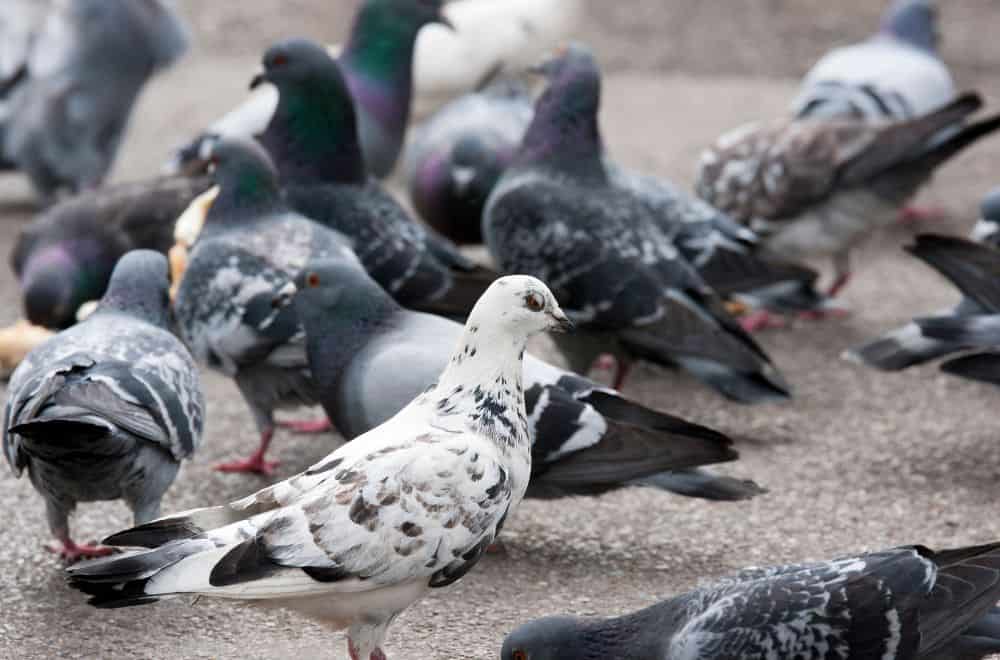
Depending on where you live, you’ll encounter different types of pigeon.
In the USA and Canada, there are 12 different species of pigeons and doves. They are:
- rock pigeons
- white-crowned pigeons
- red-billed pigeons
- band-tailed pigeons
- Eurasian collared doves
- spotted doves
- Inca doves
- common ground-doves
- ruddy ground-doves
- white-tipped doves
- white-winged doves
- mourning doves.
In the UK, the most common species by far is the wood pigeon. But you’ll also find turtle doves (the British name for the bird known in the US as mourning doves), collared doves, stock doves, and rock doves.
And across the world, there are no fewer than 352 members of the Columbidae family of pigeons and doves.
Whatever the species, all pigeons make two particular kinds of vocalizations: coos and grunts. We’ll look at both categories in more detail. And we’ll also check out some of the subtle variations in the calls made by different species.
Sounds and noises pigeons make
1. Cooing
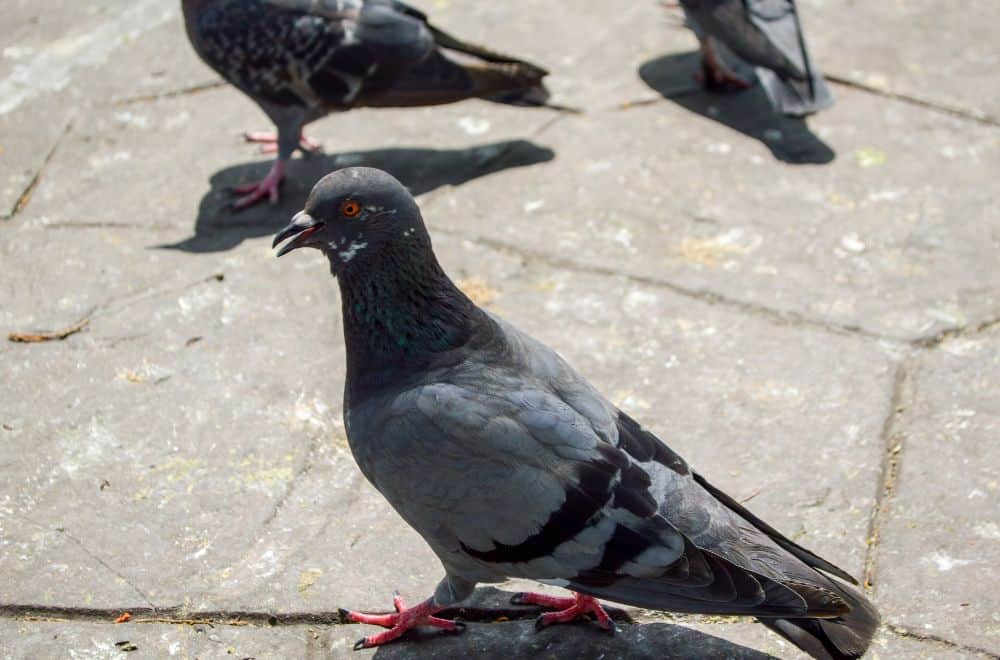
No other birds make a sound quite like the gentle throaty coo of a dove or pigeon. It’s a beautiful and atmospheric thrum, reminiscent of warm summer evenings.
But why do pigeons coo?
Well, just like humans speaking, pigeons coo to communicate. The volume varies, generally according to how far they need their call to travel.
They might be addressing themselves to a mate, a rival, or other pigeons in the same flock. Watching their behavior will give you clues as to what’s going on.
If they’re strutting and fanning their tail feathers, they may be defending their territory against a trespasser.
If they’re doing neat little pirouettes in front of another bird, it’s probably a gentleman pigeon trying to impress a lady. This often happens near the nest, but sometimes takes place further afield.
And people who have pigeons as pets have suggested that longer cooing patterns could signify contentment. In other words, pigeons sometimes appear to be singing simply because they’re happy!
The coo of the wood pigeon
The call of the British wood pigeon has a very distinctive rhythm. It’s been likened to “My toe bleeds, Betty!” or “Take two cows, Taffy!”. In different parts of the country, people use different phrases to attempt to mimic it.
But while those phrases mirror the cooing rhythm, they’re not quite the noise the wood pigeon makes. To human ears, the five coos that make up the call (my-toe-bleeds-Bet-ty!) are a single phrase. But it seems pigeons don’t think the same way.
Listen carefully to any wood pigeon, and you’ll find they all stop cooing at the same point in their call. And the phrase is actually seven coos long, rather than five. In other words, it’s more like “My toe bleeds, Betty! My toe –”
It’s an abrupt finish that sounds as if they’ve been interrupted. But it happens almost every time. Who knows why!
Unfortunately, almost every online video finishes recording the call neatly after five coos. Here’s one example from Youtuber Birdfun. So you’ll have to listen out for a real life wood pigeon to hear the difference.
The coo of the Eurasian collared dove
The Eurasian collared dove, on the other hand, keeps things simple with a three beat coo. The emphasis is on the second coo – it sounds like coo-COO-cook.
Both males and females use the same call, although males tend to be louder (no comment). And the three-coo sequence is repeated anything from three to twelve times.
If the cooing is relatively high pitched and rapid, it’s likely to mean one of two things. Either the pigeon is seeking to attract a mate, or they’re defending their territory from another bird.
If the cooing is lower and slower, it usually accompanies nest building or searching for nesting sites.
The coo of the mourning dove
The coo of the mourning dove is what gives it its name. The soft cry has a distinctly plaintive tone.
It starts with a soft coo-oo sound, followed by a longer series of five coos. The second of those five is the longest and loudest – coo-OOOO-oo-oo-oo. Indeed, the longer series is not a million miles away from the call of the wood pigeon.
If you’re close enough to the mourning dove and listen carefully, you may also hear a slight grating sound between the first and subsequent coos. It’s almost like the dove is clearing its throat ahead of the main event!
This particular call is known as the “perch call” and it’s most usually made by single males. Its haunting quality sounds a little like the hoot of an owl.
There’s also a shorter three-note version, again with the second coo being the loudest and longest. This call is usually made by male doves during nest building, or to attract females.
The coo of the red-billed pigeon
The red-billed pigeon is one of the larger pigeon species in the USA. It’s found from southern Texas all the way to Costa Rica. And it has yet another variation on the coo.
These pigeons have a five-part call. It starts with a long coo, followed by four shorter notes – cuk-c-c-coo – which gradually increase in pitch.
2. Grunting
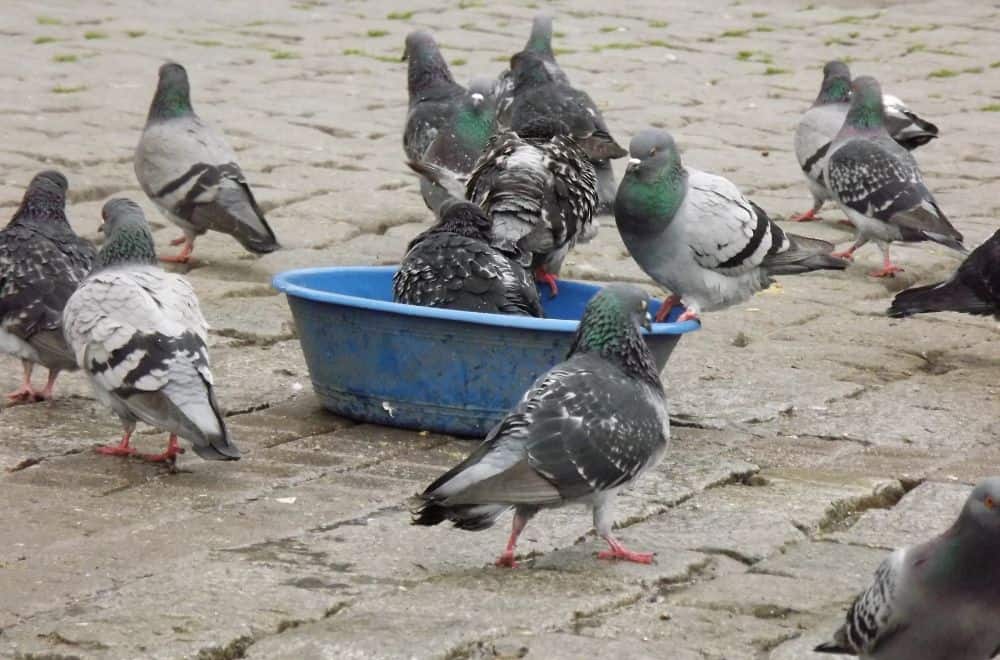
Coos aren’t the only vocal sounds made by pigeons. They also produce shorter noises, often referred to inelegantly as “grunts”.
These grunts are often a sign that the pigeon is alarmed. And just like cooing, exactly what they sound like can vary from species to species.
Rock pigeons, for example, make soft noises that would fit anyone’s idea of grunting. But if a Eurasian collared dove is alarmed or excited, it makes a sound like hwaah. It makes this same sound just before alighting, too.
And white-crowned pigeons of both sexes make low sounds that are almost like growls.
If you keep a pigeon as a pet, persistent grunting could be a sign of injury or distress. If you can’t spot a cause and the grunting continues, it’s best to take your bird to a vet. They’ll be able to check for any problems.
3. Wing claps
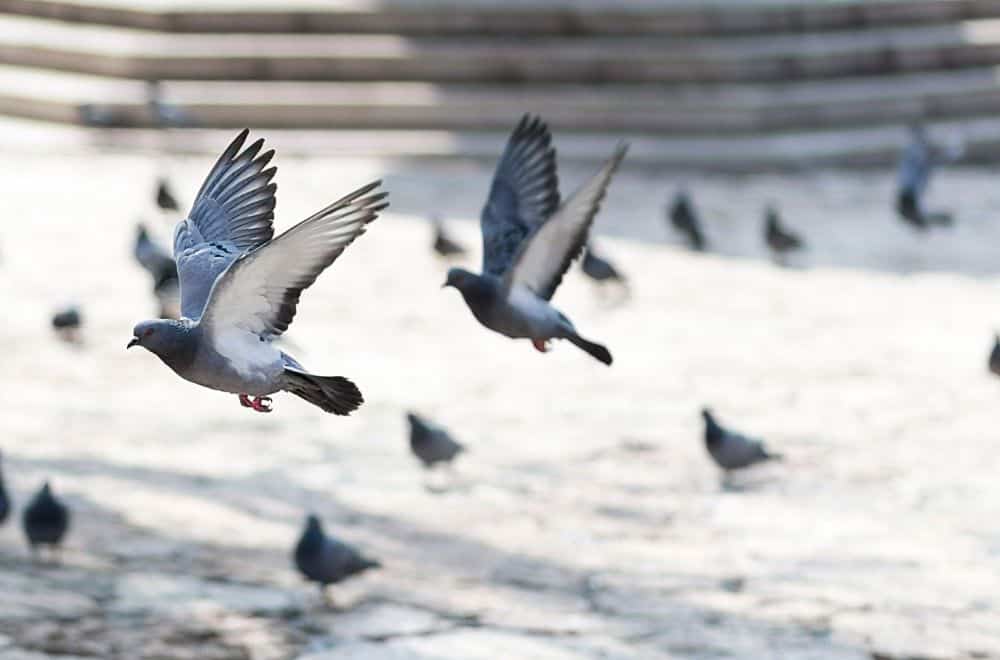
Not all the sounds pigeons make are vocal. They also make some distinctive noises when they move around. And one of those characteristic sounds is the wing clap. This happens when a pigeon slaps its wings together above its body.
Wing claps are often heard when the pigeon suddenly takes flight, or when they’re trying to warn off intruders. They can also be part of courtship displays, with male pigeons clapping their wings to impress potential mates.
Pigeons aren’t the only birds to use wing claps. Short-eared owls, for example, use them too, and for similar purposes. The owls will clap their wings rapidly, between two and six times per second. The result sounds a lot like a round of applause.
4. Stamping
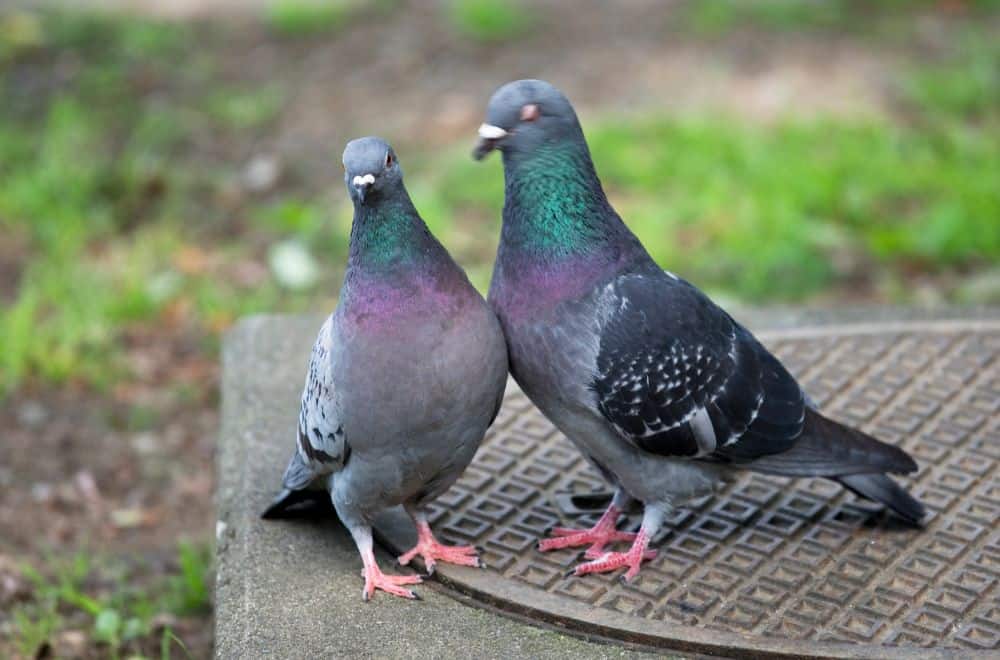
When pigeons stamp their little feet, it’s done with a purpose. It’s designed to produce a noise that will get the attention of other pigeons. Sometimes the aim is to impress a would-be mate. Sometimes it’s to intimidate a rival.
Stamping is forceful and noisy. It shouldn’t be confused with shuffling, which is a similar movement but a quiet one. In this case, the pigeon will raise and lower its feet whilst standing in the same place. And it’s sometimes, though not always, accompanied by wing fluttering.
Some people who keep pigeons as pets refer to this shuffling movement as a “happy dance”. They observe that pigeons seem to do it when they’re relaxed or excited.
It’s not always good news for pigeon fanciers, though. Sometimes, repeated foot stamping could be a sign that the bird has a problem with red mites. These are parasites that feed on the blood of birds that roost at night – including pigeons.
They live in places where the birds roost, rather than on the birds themselves. Fortunately, there are a range of good treatments on the market for eradicating red mites from pigeon lofts and aviaries.
5. Whistling
Although it’s referred to as whistling, this sound – made by the mourning dove – isn’t actually a vocalization. It’s made by the bird’s wings, and it happens on both take-off and landing. This YouTube video has some great examples of wing whistling.
It’s thought that it might be a way of scaring off predators, or possibly of warning other pigeons of danger nearby.
Pigeon sounds: a roundup
That brings us to the end of our round up of sounds and noises pigeons make! We hope you’ve enjoyed learning more about them.
While there are subtle variations between different species, the fundamental pigeon sounds are the same. Vocalizations fit broadly into the categories of either cooing or grunting. And pigeons also use their wings and feet to clap, stamp and even whistle.
